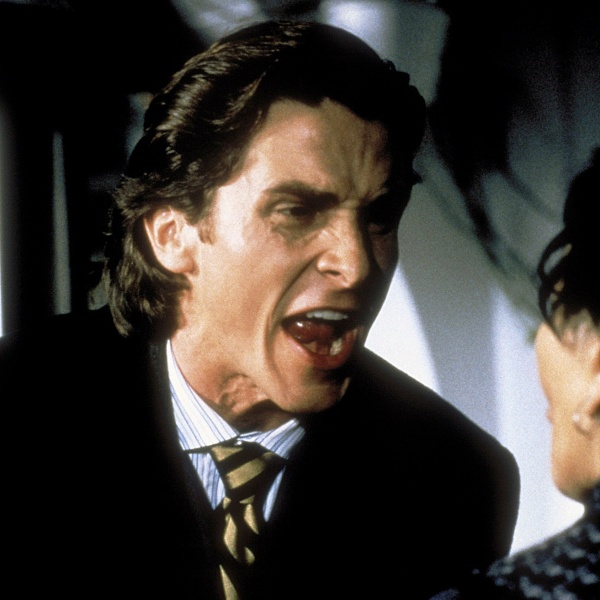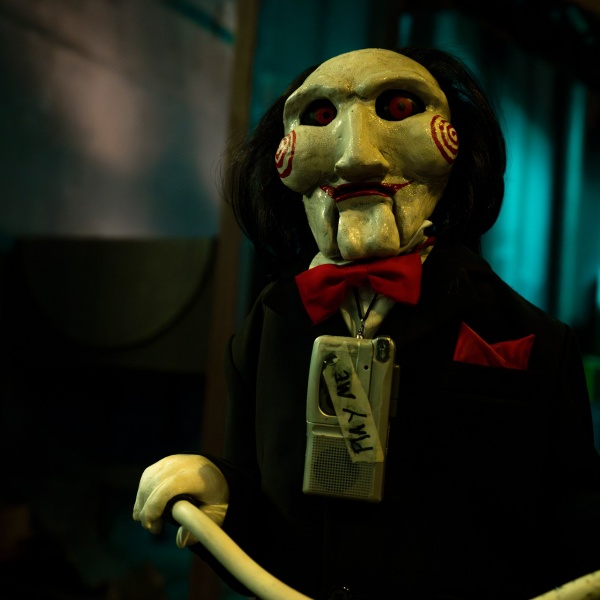One of the basic tenets fledgling filmmakers are taught and encouraged towards in film school, at least when they’re starting out, is to pick a simple, ideally single-setting location for practical reasons: budgets and lack thereof, permits, control, lighting ease, etc. If you’re a broke film student with little means, the easiest way to make a film is to set it in one environment where you ideally have total control.
To wit; Quentin Tarantino set his heist picture “Reservoir Dogs” within a warehouse and never actually showed the heist, instead choosing to keep the inside as an interior shoot save for a few scenes outside that were probably shot in day or two. Interestingly enough, of our list of the best single-location films, almost all these filmmakers set these films in a single setting by creative choice and not because they were forced to. The methodology behind it isn’t far removed from Jack White‘s less-is-more manifesto within the White Stripes: forcing yourself to be creatively inventive by subtracting all the toys you normally have at your disposal and returning back to basics.
Danny Boyle‘s “127 Hours” hits theaters today in limited release, and while it’s not strictly set in a single location, the vast majority of the film is set in a single, claustrophobic canyon, with canyoner Aron Ralston trapped under a boulder. Boyle uses every trick in his cinematic vocabulary to keep the situation fresh, but we thought we’d examine how other filmmakers, from Alfred Hitchcock to, most recently, “Buried” director Rodrigo Cortes, have dealt with a single location.
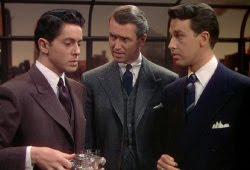 “Rope” (1948)
“Rope” (1948)
In “Rope,” based on the real life case of Leopold and Loeb, two university students who believed in Nietzsche’s Übermensch theory of murder as the ultimate act of intellectual superiority, Alfred Hitchcock throws up a number of technical hurdles in his way in bringing the story (based on the 1929 Patrick Hamilton play) to the big screen. In addition to the single location setting, an apartment, Hitchcock plays out the film in (more or less) real time (watch the sun change position outside the window throughout the film) and attempts to present the film as one uninterrupted take thanks to some clever editing. While the technical gambits don’t always work and are at times distracting, the overall effect can’t be denied. With terrific lead performances by John Dall and Farley Granger as the murderous duo, and the always reliable James Stewart as their suspicious teacher, “Rope” is a wickedly fun cat-and-mouse game that raises the stakes by keeping all the players in the frame for the entire run time. Dall in particular is a standout as Brandon, a bundle of giddy joy combined with a perverse sense of accomplishment while Granger holds his own as the much more nervous and guilt-ridden Phillip. Even if you know just how their “perfect crime” is ultimately revealed, “Rope” is still great fun to watch. The verbal sparring is delicious and the streak of homo-eroticism running through the film is remarkable for its time. Not many of the single setting films on this list attempt as much as Hitchcock juggles here, but for the most part it works, and more importantly, the story quickly becomes much more fascinating than the novelties used to tell it. [B+]
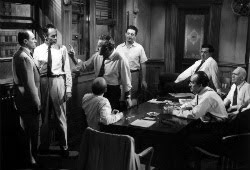 “12 Angry Men” (1957)
“12 Angry Men” (1957)
Pedants, stand down – while the film is bookended with scenes outside, and the bathroom is briefly featured, “12 Angry Men” is at heart a single-location film; everything of import happens, enclosed in time and space, in a sweaty, featureless jury room where the 12 men of the title are sent to decide the fate of a man accused of murder. Based on (and apparently differing little script-wise from) a teleplay of the same name, that the film never feels anything but cinematic, despite its TV roots and the deliberate theatricality of its staging (witness the beautiful choreography of that devastating moment when the ranting racist reveals himself, and each of his fellows one by one stands and turns his back) is in large part due to the blistering performances, marshaled by a never-better Sidney Lumet throughout the course of an arduous rehearsal process. Special mention must go to Henry Fonda, whose work here is a masterpiece of understatement and restrained intelligence and promotes the film from a meditation on liberality, the judicial system and the meaning of justice (interesting) to a keenly-observed essay on the mechanics of power and manipulation (interestinger). Yes, some of the details may seem trite now – a witness GASP wasn’t wearing her glasses; an old man SHOCK drags his leg – but more often it’s not the ‘facts’ that change minds, instead each man is proven wrong by exposing his hubris, bias and pettiness to the rest, and to himself. This perhaps is the film’s most remarkable achievement; it is a towering monument to the idea that the ‘ordinary man’ is at heart good and kind — it’s just that sometimes he need a little reminding. [A]
 “Lifeboat” (1944)
“Lifeboat” (1944)
Alfred Hitchcock certainly had a sort of masochistic creative bent for putting his productions into extra challenging situations, like say, within the confines of a lifeboat with eccentric diva (and noted panty eschewer) Tallulah Bankhead. Then throw in a set piece of a primitive leg amputation for fun! The WWII ensemble picture garnered Oscar noms for Best Director, Best Original Motion Picture Story (by John Steinbeck), Best Black and White Cinematography (give it up for ghosts of Oscar categories past), and a whole host of controversy for what was viewed as a propagandist portrayal of a Nazi captain who ends up aboard the lifeboat. The motley crew thrown together after a passenger ship and German U-Boat sink each other make up a little model U.N. of races, creeds and nationalities, and everyone’s got to learn to get along in order to survive — and not all of them do. Hitchcock presented himself with quite the challenge in shooting this film — sticking a bunch of actors in a lifeboat in the middle of the ocean doesn’t give a director that many visual options, but he staged the actors within the frame in a dynamic layered way, utilized close-ups, and masterfully created a whole universe within the confines of the boat by simply filling the frame with characters. Despite the small location, the film never feels claustrophobic. Hitch also added on another storytelling challenge to his plate by completely eliminating the score (except for the very beginning and end), letting the audience not be influenced by musical cues, learning what they needed to know from the actions of the characters, Hitch’s unparalleled camera work and editing, and the desolate diegetic sound of the ocean slapping against hull. All single-location filmmakers out there: bow before your master. [A]
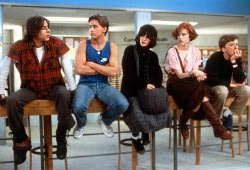 “The Breakfast Club” (1985)
“The Breakfast Club” (1985)
The bane of high school existence — aside from the awkwardness and not fitting in — is detention, so it was kind of brilliant for John Hughes to use physical incarceration as an emotional metaphor for the angst and anguish all teenagers, no matter their station in school, feel. Perhaps not as claustrophobic as some films on this list, “The Breakfast Club” still fits the bill as the picture is entirely set within a high school on the worst day possible for an adolescent: a Saturday. You’ve seen it, so we don’t need to tell you much more about this ’80s classic that forces a nerd, a jock, an outcast, a criminal, and a priss to work out their collective issues, but it’s an inventive premise that obviously worked in spades. There’s a lot of anger and tears in the dramedy when the students in the film are forced to confront their fears and demons, but in the end it’s this candid self-analysis that leaves them, and us the viewer, feel a little bit more understood in a world that’s a largely cruel and unforgiving. [A]
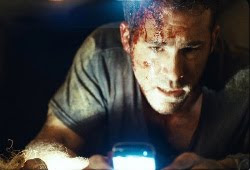 “Buried” (2010)
“Buried” (2010)
The concept is simple: a man wakes up buried alive in a coffin and has to fight for his life. And to be sure, the Ryan Reynolds film got a lot of early buzz and heat for its ambitious conceit that found the actor onscreen, by himself, for the entire length of the film. And while Reynolds proves himself capable of maintaining a helluva presence for the runtime of the picture, it’s too bad the script by Chris Sparling can’t match the energy put in by the film’s lead actor. Plagued with the issue of Reynold’s character having unbelievably strong cell phone service underground, the script only gets worse from there. In essence, “Buried” is 90 minutes of phone calls, and because those characters are only voices for Reynolds to bounce off of it quickly becomes apparent just how thinly constructed the entire enterprise is. Reaching for some narrative weight, the script shifts into some kind of late stage political statement but it fails to convince. Director Rodrigo Cortes does his best to creatively stage a film that takes place within a supremely confined space but there are only so many different ways you can frame Reynolds in a closeup. All smoke and no fire, “Buried” literally boxes itself in. [C-]
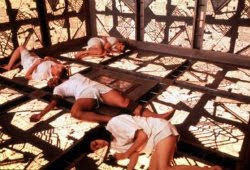 “Cube” (1997)
“Cube” (1997)
An exercise in doing a lot with a little, “Cube” was shot in 20 days on a single 14’x14’ set for just $365,000 CAD, yet spawned two subsequent films (a sequel and a prequel) and quite the cult following. It is a lean, absorbing piece of work in which the distinctly Kafkaesque gimmick (a group of strangers wake up in a nightmarish cube consisting of constantly shifting and almost identical-looking rooms, many of which are rigged to kill), like in all the best sci-fi, really only exists as an excuse to indulge in a little old-fashioned philosophizing and some “Survivor”-style power plays as temporary alliances form and crumble and people turn out to be Not What They Seem. We say like the best sci-fi, though, because even at its best, “Cube” never actually gets there; it neither takes that leap into the truly strange and/or twisted, like “2001,” or even “Primer,” or “Pi,” but nor does it give us any actual answers, and so it rather falls between all available stools, with some rather threadbare acting and characterization causing it to fall short of being a “Sunshine”-style ensemble piece. But of course these are mostly comparisons with films that had many, many times “Cube”’s budget, so it’s maybe churlish to nitpick. If nothing else, we have it to thank for heralding the arrival of a very promising new horror/sci-fi director in Vincenzo Natali, who has since brought us the likes of “Cypher” and “Splice” (which we liked a lot), and is currently attached to that sci-fi Holy Grail — an adaptation of William Gibson’s “Neuromancer.” [B]
 “Phone Booth” (2002)
“Phone Booth” (2002)
A testament to the survival of the high concept in Hollywood, screenwriter Larry Cohen’s pitch for this film lingered on the shelf for just over 40 years, having once been developed by none other than Alfred Hitchcock. The film ended up in development under the watchful eye of a considerably less-talented filmmaker, one Joel Schumacher, best known for permanently putting an end to the Batman franchise in the ’90s. The end result is just about what you’d expect, although Schumacher does wrangle a compelling lead performance from a then-untested Colin Farrell (he had earlier worked with Schumacher in what amounted to the director’s best film of the aughts, 2000’s Vietnam training camp drama “Tigerland”). As singularly unfortunate douchebag publicist Stu Shephard, Farrell sweats, screams and tears at the glass compartment he is permanently enclosed in under the watchful eye of a nameless crackshot sniper (Kiefer Sutherland, who spends almost the entire movie cooly informing Stu of his imminent demise through voice-over and, unsurprisingly, nails it). Between the two men stands trusty straight-arrow black police officer archetype Captain Ramsey (Forest Whitaker, always reliable and bringing a certain degree of veneration to a tired stock character). To spoil the torments Stu undergoes and whether he ever exits the phone booth alive would undermine Schumacher’s mushy dramatic turns — when your whole film is a set-piece, there’s only so much gas you can burn out before things slow down to molasses. Luckily, “Phone Booth” keeps the tension on the up-and-up and turns in a serviceable, occasionally exciting and always watchable boilerplate thriller with a unique gimmick that, for the most part, wears off less quickly then you’d think. [B]
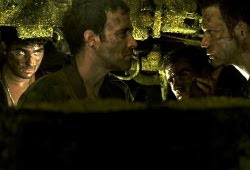 “Lebanon” (2009)
“Lebanon” (2009)
The very recent “Lebanon” makes this list not only because literally all of the action is seen from the vantage point of a tank, but also because this single location is used to startling effect. Samuel Maoz’s reconstruction of his own experiences as an Israeli tank gunner during the 1982 war between Israel and Lebanon takes place (with the exception of the first and last two shots of the film) entirely inside an Israeli tank supported by a team of paratroopers who move into enemy territory on the first day of battle. The Maoz stand-in, gunner Shmulik (Yoav Donat) remains holed up in this contraption for the duration of the film, along with his crew, headed by a commander who grapples with his men’s conflicting personalities. You’re no doubt familiar with the expression that when you put multiple people in a room for a long period of time, seams will inevitably come apart and they’ll come to blows. In “Lebanon,” the tank is barely even a room and the men will either live or die by the day’s end – and if not today, then tomorrow. The tank gives protection, but it is also a trap, one that has no way out, no emergency exit. If the tank burns, the flesh does too. “Lebanon” is balls-to-the-wall filmmaking and it should be seen, experienced, if not necessarily enjoyed. [B+]
 “Panic Room” (2002)
“Panic Room” (2002)
For his follow-up to the originally critical and commercial failure “Fight Club” (we all know how that one turned out), David Fincher set out to give the modern thriller an injection of anal-retentiveness only a couple of visionaries in this business can dish out. With “Panic Room”, Fincher painstakingly outlines the design of a massive townhouse about to come under siege by three men of very different temperaments — the hot-head Junior (Jared Leto), unhinged bus driver Raoul (Dwight Yoakam) and the complacent, though conscientious, safe cracker Burnham (Forest Whitaker, who between this and “Phone Booth” dominated the 2002 market on authoritative black supporting characters in enclosed spaces). The tension in this single location example comes from Meg (Jodie Foster) and Sarah Foster (Kristen Stewart, biting her lip with the best of them in an early example of the apathetic acting that would carry her through the ‘Twilight‘ series), a mother and daughter whose only misfortune was moving in on the wrong day. Luckily, the house has a newfangled “panic room”, impenetrable and stocked with food and cameras surveying the house. The problem is the safe the thieves are looking to crack is in the room and they have every intention of getting in, short of blowing up the house. As directed by Fincher and (mostly) shot by Conrad W. Hall (the son of the late great Conrad L. Hall), “Panic Room” is murky, methodical and gorgeous but nothing more outside of a razor-sharp thriller with a tantalizing concept. Another film as testament to Fincher’s micro-managing virtuoso technique, “Panic Room” is a nasty little lark from the filmmaker, but little more. Still, in the hands of Fincher, that puts the film head and shoulders above the competition. [B-]
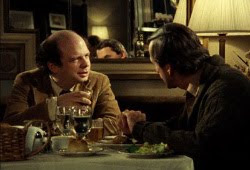 “My Dinner With Andre” (1981)
“My Dinner With Andre” (1981)
Aside from say, Hitchcock’s purposeful experiments and personal challenges (many of them listed here) Louis Malle’s early-eighties talk fest may be the apogee of single-settings. Essentially an 110-minute conversation, “My Dinner With Andre,” is exactly that, an extended dinner between two friends shot in real time discussing the nature of life, theater and more. The subjects are the peculiar actor Wallace Shawn and his friend and experimental theater director, Andre Gregory. Gregory is an inquisitive dreamer while Shawn is a more cynical typical New Yorker, and while there’s little friction in their discourse, their subtle differences make for an absorbing dichotomy. While it also sounds like cinema verite gone wrong — and it basically goes against every filmmaking and screenwriting 101 rule ever — the dinner with Andre is absolutely engaging, watchable and engrossing. The tastemaking Criterion Collection didn’t put it out as an artifact, they want to make money off it too, you know and they realize it’s an ever-compelling film (and much-drier stuff does exist in their wares — see single setting clunker “Secret Honor” by Robert Altman). During their supper, Wallace and Gregory touch philosophically upon subjects like the nature of life, existence and theater, but always with a open and inviting curiosity; there’s no pedantic answers or postulating — this is colloquy at its best. 100 minutes later when the breaking of bread is done and the wine is drunk, the friends go their separate ways and the audience is left to digest the thoughtful topics discussed. A convention-buster in every sense that defies almost every trope of feature filmmaking and storytelling — it’s not a documentary in any sense and heavily scripted based on real life conversations between the two leads — “My Dinner With Andre” is that rare and enjoyable rule-breaker that every film lover should at least see once. [B+]
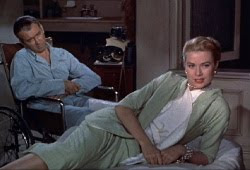 “Rear Window” (1954)
“Rear Window” (1954)
Another single setting film, another Alfred Hitchcock masterpiece. This time the setting is a Greenwich Village apartment complex where a New York City summer heatwave has caused the apartment dwellers to keep their windows open. Unsatisfied with simply restricting the setting of his film, Hitchcock presents himself with another challenge by restricting the film’s point of view to that of a single character: Jeff Jeffries (played by a perfectly cast Jimmy Stewart), a photographer with a broken leg stuck in a wheelchair. Confined to his apartment, Jeffries, who is occasionally visited by his nurse (Thelma Ritter) and his girlfriend (a delectable Grace Kelly), turns his attention to the various neighbors across the courtyard from him who he can see through his living room window. The lonely woman with no husband. The unconventional artist. The enamored newlyweds. The single musician who drinks. The childless couple who love their dog. A curvy ballet dancer. And of course the couple who are always fighting. One day the wife in this acrimonious couple disappears. Jeffries, looking into the couple’s apartment from the confines of his own living room, sees mounting evidence of what he thinks might be the wife’s murder at the hands of her husband (Raymond Burr). The setting of the apartment complex quickly becomes Jeffries’ world as he obsesses on finding more clues. At the same time, we the audience lose ourselves in Hitchcock’s economic storytelling, where no single detail is wasted. Looking over Jeffries’ shoulders through Hitchcock’s long shots of the apartment complex we search for clues in hopes of figuring the mystery out. And before we know it, Jeffries’ living room has become our own. [A]
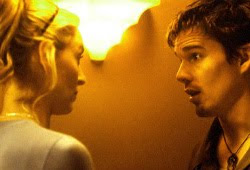 “Tape” (2001)
“Tape” (2001)
He’s a great theater actor, but on screen, Ethan Hawke can be a little bland. Unless, that is, he’s working with Richard Linklater, for whom Hawke’s constantly give his best screen performances. And few are better than than one he gives in “Tape,” Linklater’s adaptation of the Stephen Belber play. Set entirely in real-time, without ever leaving the faintly squalid motel room in which it’s set, Hawke plays Vince, a small-town drug dealer out to force his oldest friend Jon (Robert Sean Leonard, another theater veteran rarely used well on screen) to confess to raping Vince’s ex-girlfriend, Amy (Uma Thurman) when they were younger. The twists and turns rarely play to your expectations of the characters, and, for the most part, Linklater’s camerawork, while not exactly his prettiest, is engaging, and for the most part prevents the film from feeling too stage-bound. But really, as is so often the case for a film set in one location, it’s an actor’s showcase, and all three stars have rarely been better. Something of a minor experiment in the director’s canon, but an underrated one nonetheless. [B+]
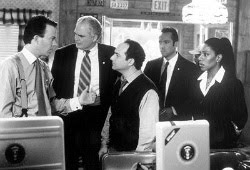 “Deterrence” (2000)
“Deterrence” (2000)
There’s a long tradition of the claustrophobic push-the-button nuclear thriller, from Sidney Lumet’s “Fail Safe” to the more recent “Crimson Tide” and “Thirteen Days,” but none have ever been quite as claustrophobic, at least in location, as Rod Lurie‘s “Deterrence.” The directorial debut of former film critic Lurie, it’s set in 2008, and sees a president on the election trail (Kevin Pollak) trapped in a diner in Colorado by a snowstorm, while in the midst of a bout of nuclear brinkmanship with an Iraq run by Uday Hussein, who have invaded Kuwait. While very much a first film, Lurie keeps the tension running, and while former stand-up Pollak isn’t the most obvious president in cinema history, he’s surprisingly good, and fits the character — a Jewish VP unexpectedly elevated to the big seat by the earlier death of the commander-in-chief. But unfortunately, the film’s mostly a misfire, principally because of an unconvincing supporting cast, most notably Sean Astin, abetted by a ludicrous goatee, as a small-town racist, and an increasingly silly plot. Things finally reach a peak with the ending, which isn’t just morally highly questionable (and not really in a deliberate way), but also a complete narrative cheat. It’s not uninteresting, but you’re better off sticking with “Fail Safe.” [C-]
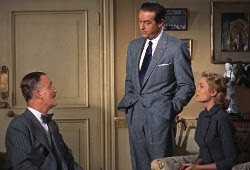 “Dial M For Murder” (1954)
“Dial M For Murder” (1954)
Okay, so we’re slightly cheating here as the film does have a couple of sequences outside the home of Margot (a luminous as usual Grace Kelly) and Tony (Ray Milland), but we’ll overlook that as “Dial M For Murder” is another thrilling “perfect murder” caper from Hitchcock. You see, Tony has found out that Margot has been been having an affair with dashing crime-fiction writer Mark (Robert Cummings) and roiling with resentment and jealousy he plans to have her killed. He stages an elaborate plot which includes blackmailing Swann (Anthony Dawson), an old Cambridge alumnus, to do the deed: Swann will wait behind the drapes one evening when Margot is guaranteed to be home, and Tony will call the house. When she goes for the phone, Swann will emerge and kill her. As usual, the set up seems impenetrable but a series of bad luck and missteps of course send the plan spinning out of the control. Hitchcock once again pulls off a bit of a marvel, taking a tale that on paper is about delayed calls and misplaced keys, and turning it into a verifiable nail biter. Intriguingly, he also manages to get the audience to sympathize (somewhat) with Tony; as the plan unravels, you can’t help but feel a tinge of pity for the guy. The film is also notable for not only being Hitchock’s second foray into color but also 3D. It’s no surprise that the use of 3D here is distracting (but frankly, no worse than the same kind of “in-your-face” antics that still happen today), but the director’s use of color (watch Kelly’s dress color change when she’s with Tony and Mark) is carefully thought out. Slightly stagy and over-explained at the start (it is based on a play after all), the film really whips into shape once the plot is set into motion and as usual, the sheer enjoyment takes you out of its confined setting. [B]
 “1408” (2007)
“1408” (2007)
“I warned you about 1408,” Samuel L. Jackson’s enigmatic Dolphin Hotel manager Mr. Olin booms in the direction of Mike Enslin (John Cusack), trapped in the supposedly bedeviled hotel room in this cinematic incarnation of Stephen King’s short story of the same name. The concept is deliciously simple — Enslin, a successful author who makes his living harping on supposedly haunted locations, takes on the Dolphin Hotel’s infamous room 1408 for his next assignment. Ignoring the imploring of Mr. Olin, Enslin settles into 1408 and quickly realizes he’s well over his head — probably around the time the insanely creepy placement of “We’ve Only Just Begun” by The Carpenters shatters the silence of the amply-sized living space. Director Mikael Håfström uses special effects sparingly but very effectively, establishing the unpredictable metamorphorsis of the room that includes an absolutely fantastic scene of literal reality shattering toward the end of the film. Cusack is mostly on his own as Enslin and he delivers a surprisingly measured performance that banks fruitfully on his damaged humanity. Enslin is in many ways a great candidate for 1408, with his own share of emotional baggage, the spirits possessing the room can unlock and juice for maximum psychological damage. While not especially memorable, “1408” is skilfully directed and a pleasure to take in and shudder and shake at in appropriate moments. [B+]
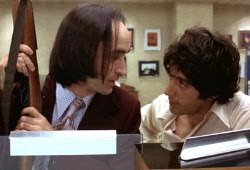 “Dog Day Afternoon” (1975)
“Dog Day Afternoon” (1975)
Not much more needs to be said about Sidney Lumet’s terrific heist film, “Dog Day Afternoon,” but what another stroke of genius to build tension by creating the picture as a botched heist where the thieves are trapped inside on a hot afternoon in New York City (OK, it’s based on a true story, but still). The film gets most of its mileage from its two leads, the manic and loose-limbed Al Pacino playing the two-time loser Sonny at his very finest and the frightened, and dim-witted Sal (a wonderfully dumb John Cazale). The job is just supposed to be your average bank job in Brooklyn, but due to a comedy of errors, everything goes wrong, the police arrive and the inept criminals way in over their heads are forced to take hostages and hole up inside hoping the mayor will meet their demands. The volatility escalates as the situation stretches out while the cops (an excellent Charles Durning) try to negotiate with the mercurial and sweaty bank robber, clearly on the edge. Later on (spoiler in case you haven’t seen, and why on earth haven’t you?), we learn why Sonny’s so nervous; his lover (Chris Sarandon) tries to talk him out of the robbery and we discover the machinations behind the crime is motivated by Sonny’s desire to get him a sex-change operation. It’s a fascinating twist to a classic and gritty nail biter. [A]
Honorable Mentions: The eagle-eyed among may have noticed a few gaps here, mostly involving films set entirely on trains. But with “Unstoppable” on the way, we’re saving those for a rail-bound feature next week, so be patient. Otherwise, there are a few films that are worth mentioning, even if they depart from their single location a little too much to be included here. Polanski’s “The Tenant” is a minor work from the director, but not uninteresting, and is let down by the central performance — in this case, Polanski himself. The astonishing one-take “Russian Ark” is an extraordinary feat of filmmaking, even if it sometimes feels more like an art installation than an actual film. And Lars Von Trier’s “Dogville” and “Manderlay” are both excellent, although the single-location setting is a Brechtian conceit, rather than a true entry to the genre.
Otherwise, Duncan Jones’ sci-fi “Moon” is mostly set in the confines of a space station, although occasionally makes excursions onto the lunar surface. Similarly, both “Sunshine” and “Das Boot” are set entirely within spaceships/submarines, but the locations are big enough that they don’t quite qualify, and Kevin Smith’s “Clerks” stretches to two different locations, and the street bridging them. This year saw two other thrillers which didn’t stray far from a single place. One, “The Disappearance Of Alice Creed,” was enjoyably twisty, nasty and well-acted, the other, the M. Night Shyamalan-produced “Devil,” was… not. Finally, no one had seen Frank Capra’s “Arsenic and Old Lace” recently enough to write it up, and, although it’s stagy in a way that, say “Rope” isn’t, it’s still worth checking out, if our faded memories of it are accurate.
— Mark Zhuravsky, Jessica Kiang, Katie Walsh, Tan Nguyen, Kevin Jagernauth, Oli Lyttelton, Rodrigo Perez


